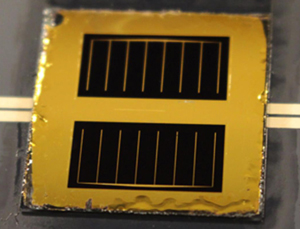- News
5 January 2016
NREL and CSEM jointly set dual-junction one-sun solar cell efficiency record of 29.8%
Scientists at the US Department of Energy's National Renewable Energy Laboratory (NREL) and at the Swiss Center for Electronics and Microtechnology (CSEM) have jointly set a new record for converting non-concentrated (1-sun) sunlight into electricity using a dual-junction III-V/silicon solar cell (published in 'Solar cell efficiency tables').
The newly certified record conversion efficiency of 29.8% was set using a top cell made of gallium indium phosphide (GaInP) developed by NREL, and a bottom cell made of crystalline silicon developed by CSEM using silicon heterojunction (SHJ) technology. The two cells were made separately and then stacked by NREL.
"It's a record within this mechanically stacked category," says David Young, a senior researcher at NREL. "The performance of the dual-junction device exceeded the theoretical limit of 29.4% for crystalline silicon solar cells."
 Picture: GaInP/SHJ tandem cells with efficiency up to 29.8% under 1-sun standard illumination.
Picture: GaInP/SHJ tandem cells with efficiency up to 29.8% under 1-sun standard illumination.
Young is co-author of a paper 'Realization of GaInP/Si dual-junction solar cells with 29.8% one-sun efficiency' (submitted to IEEE Journal of Photovoltaics). The co-authors from NREL are Stephanie Essig, Myles Steiner, John Geisz, Scott Ward, Tom Moriarty, Vincenzo LaSalvia and Pauls Stradins. Essig attracted interest from CSEM when she presented a paper 'Progress Towards a 30% Efficient GaInP/Si Tandem Solar Cell' to the 5th International Conference on Silicon Photovoltaics (SiliconPV 2015) in Konstanz, Germany last March.
"Silicon heterojunction technology is today the most efficient silicon technology for application in tandem solar cells," believes Christophe Ballif, head of PV activities at CSEM.
"CSEM partnered with the NREL scientists with the objective to demonstrate that 30%-efficient tandem cells can be realized using silicon heterojunction bottom cells, thanks to the combination with high-performance top cells such as those developed by NREL," says Matthieu Despeisse, the manager of crystalline silicon activities at CSEM.
Key to setting the record were a new design for the dual-junction solar cell and the contributions from CSEM. These first collaboration results further indicate that even greater efficiency can be achieved by the combination of NREL and CSEM cells, it is reckoned.
The funding for the research came from the Energy Department's Office of Energy Efficiency and Renewable Energy SunShot Initiative (which aims to make solar energy fully cost-competitive with traditional energy sources) and from the Swiss Confederation and the Nano-Tera.ch initiative.


